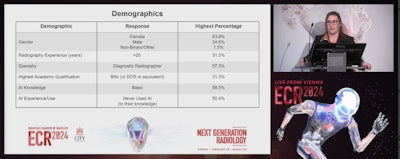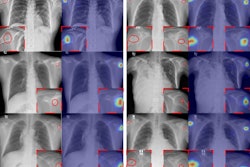While radiographers are concerned about job security, they are also optimistic about AI’s role in their future workflows, according to a presentation given March 1 at ECR 2024.
In her talk, Gemma Walsh from Whittington Health National Health Service (NHS) Trust in London, England outlined the attitudes and perceptions of radiographers -- the European equivalent to radiologic technologists -- in a project she and colleagues are leading called “R-AI-diographers.”
“Radiographers appear optimistic about the future of radiographer job roles and responsibilities,” Walsh said. “But as we all know, the AI landscape is always changing, and this [project] is a snapshot of their opinions at this time.”
AI’s potential roles within radiology workflows continue to be explored in studies, but perceptions of the technology by radiologists have also been gathered. Previous survey analyses have identified that while many radiologists share concerns over legal and workforce implications, they also acknowledge AI’s potential for improving patient care.
 Gemma Walsh from Whittington Health NHS Trust in London, England presents results from her team's "R-AI-diographers" project, outlining the perceptions of radiographers regarding the impact of AI implementation.
Gemma Walsh from Whittington Health NHS Trust in London, England presents results from her team's "R-AI-diographers" project, outlining the perceptions of radiographers regarding the impact of AI implementation.
The “R-AI-diographers” project gained insights into how diagnostic and therapeutic radiographers expect AI to change their roles and identities. The overarching goal is to improve how the radiographer workforce can be supported while technological changes occur at fast rates.
Data focused on the following areas: demographics, perceived short-term impact of AI on radiographer roles, potential medium-to-long-term impact of AI, perceived opportunities and threats on roles and careers, the preparedness of radiographers to work with AI, and the potential for future AI leadership roles.
Walsh and colleagues gathered 2,258 valid responses from 37 different European countries for their analysis. Of the total respondents, 31.3% had over 20 years of radiographer experience and 31.3% had a bachelor's degree as their highest level of education. Additionally, 50.4% of respondents reported never having used AI to their knowledge.
The team reported the following findings from their survey analysis:
- 25.9% of radiographers disagreed that AI implementation would have them focus mainly on patient care, but 39.2% agreed that it would allow them more time with patients.
- 41.39% agreed that image and treatment responsibility will remain the radiographer’s responsibility even with AI implementation, while 40% agreed that their technology problem-solving skills will improve.
- 53.9% agreed that radiation protection responsibilities will remain the same.
Additionally, the respondents were split into three near-equal ways when it came to AI and job security. Walsh said while 32.5% of respondents said that job and career opportunities will remain the same, 32.3% said such opportunities will increase and another 30.2% said they would decrease. Another 5% indicated “other” in their responses.
Finally, Walsh revealed that better patient care and outcomes as well as workflow efficiency were what respondents said they most look forward to. Meanwhile, staff deskilling and loss of jobs were the top concerns reported.
“Radiographers will need educational support to combat the fear of de-skilling and job loss,” Walsh said.
She added that the researchers will next investigate careers and leadership roles in AI for radiographers.
This presentation won the European Society of Radiology’s Radiographer Research Presentation Abstract Award. For more coverage from ECR 2024, please visit our RADCast.



















